Strategic Analysis of Qantas Airlines Using Porter's Five Forces Model
VerifiedAdded on 2022/12/21
|11
|2689
|12
Report
AI Summary
This report provides an in-depth analysis of Qantas Airlines using Porter's Five Forces framework. It explores the competitive rivalry within the airline industry, highlighting key players like British Airways and Singapore Airlines. The analysis examines the threat of substitutes, noting the dominance of airlines over alternative transport methods, but also the importance of cost efficiencies. Entry barriers, such as high capital investment and limited airport slots, are discussed. The bargaining power of suppliers, particularly regarding oil prices, and the bargaining power of buyers, influenced by service options, are also assessed. The report concludes by emphasizing Qantas's strategic capabilities in maintaining a competitive advantage in the Australian transportation sector, while acknowledging challenges like competition and the high negotiating ability of suppliers and buyers. Recommendations include customer-centric strategies and innovation to maintain market position.
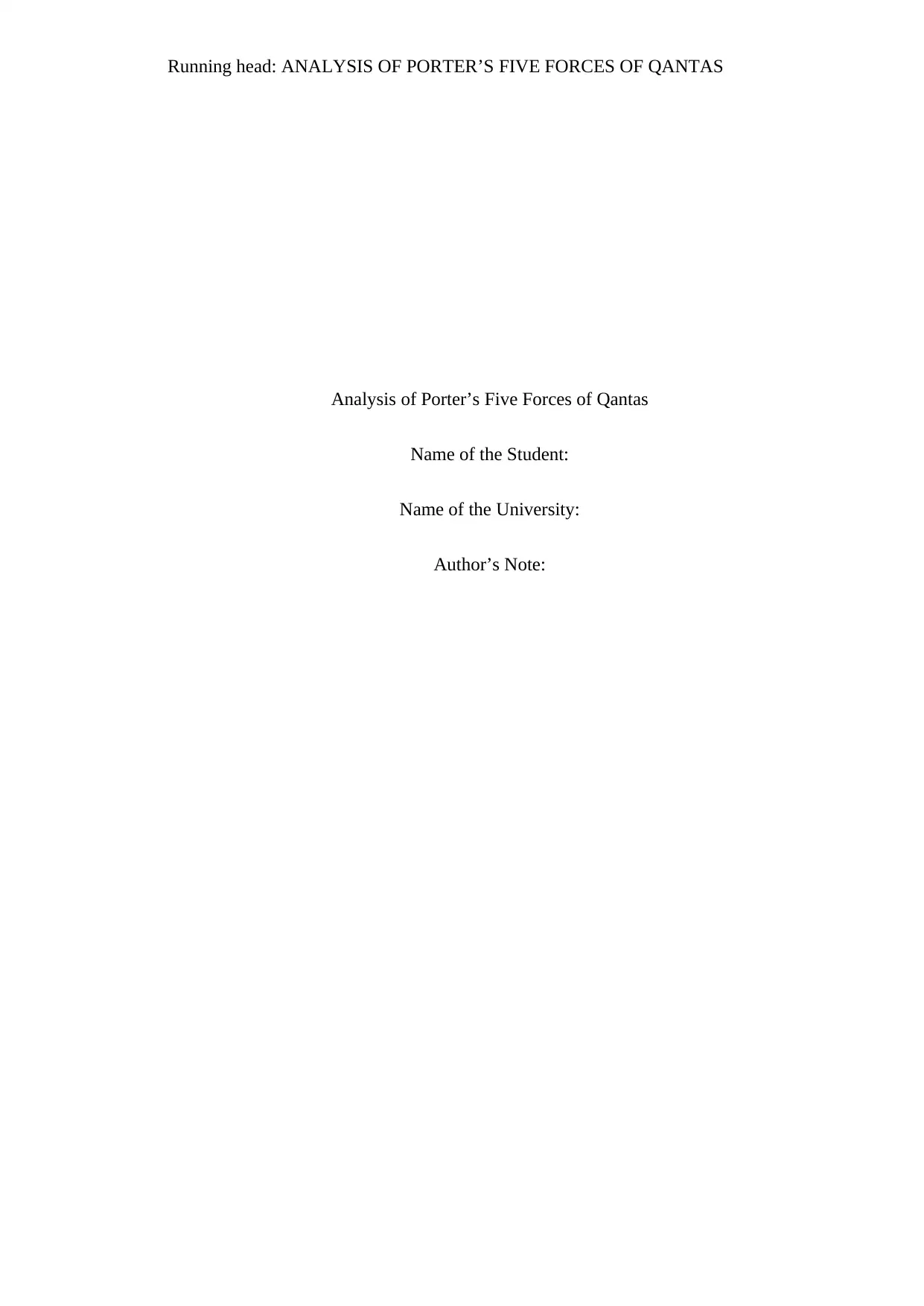
Running head: ANALYSIS OF PORTER’S FIVE FORCES OF QANTAS
Analysis of Porter’s Five Forces of Qantas
Name of the Student:
Name of the University:
Author’s Note:
Analysis of Porter’s Five Forces of Qantas
Name of the Student:
Name of the University:
Author’s Note:
Paraphrase This Document
Need a fresh take? Get an instant paraphrase of this document with our AI Paraphraser
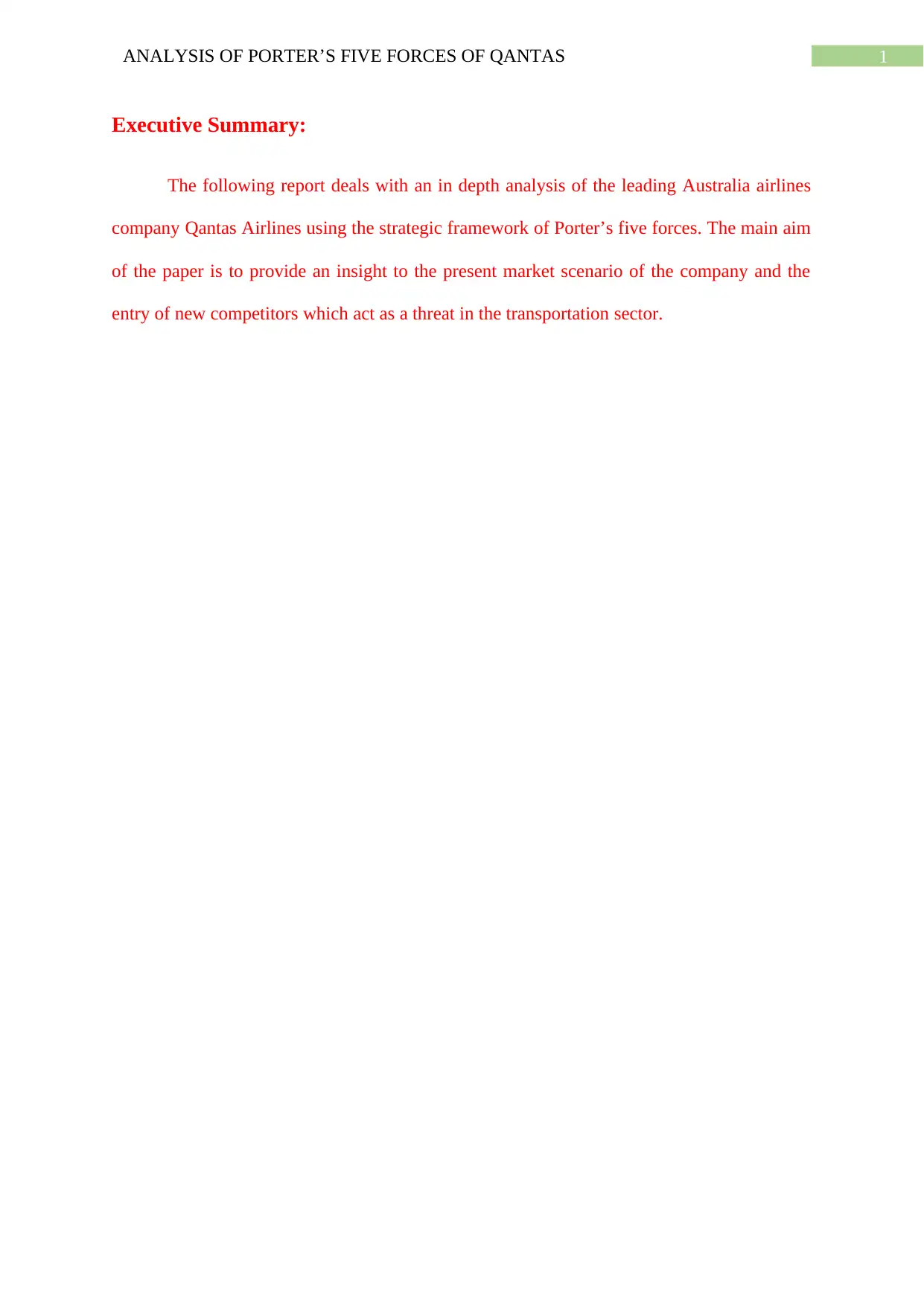
1ANALYSIS OF PORTER’S FIVE FORCES OF QANTAS
Executive Summary:
The following report deals with an in depth analysis of the leading Australia airlines
company Qantas Airlines using the strategic framework of Porter’s five forces. The main aim
of the paper is to provide an insight to the present market scenario of the company and the
entry of new competitors which act as a threat in the transportation sector.
Executive Summary:
The following report deals with an in depth analysis of the leading Australia airlines
company Qantas Airlines using the strategic framework of Porter’s five forces. The main aim
of the paper is to provide an insight to the present market scenario of the company and the
entry of new competitors which act as a threat in the transportation sector.
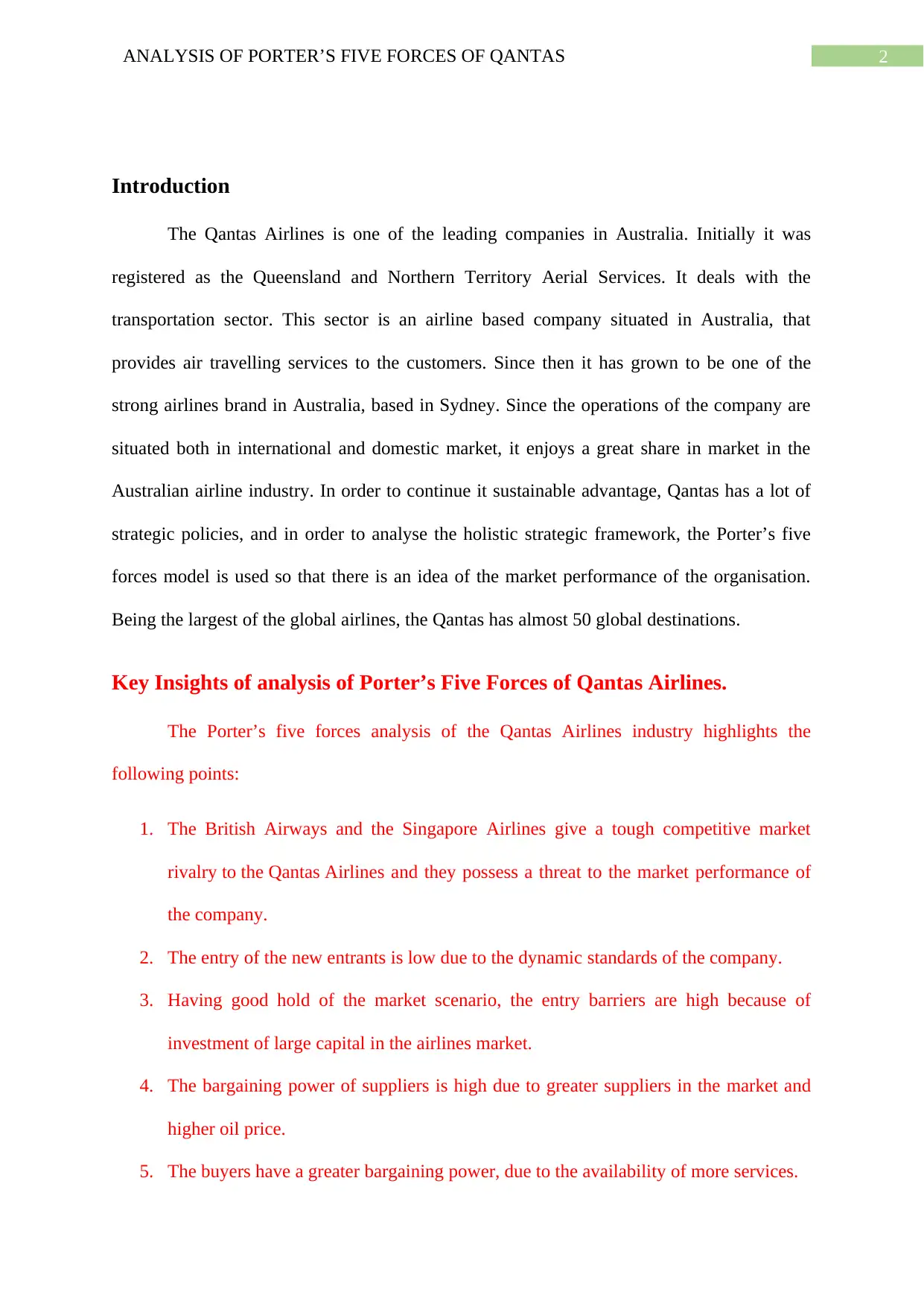
2ANALYSIS OF PORTER’S FIVE FORCES OF QANTAS
Introduction
The Qantas Airlines is one of the leading companies in Australia. Initially it was
registered as the Queensland and Northern Territory Aerial Services. It deals with the
transportation sector. This sector is an airline based company situated in Australia, that
provides air travelling services to the customers. Since then it has grown to be one of the
strong airlines brand in Australia, based in Sydney. Since the operations of the company are
situated both in international and domestic market, it enjoys a great share in market in the
Australian airline industry. In order to continue it sustainable advantage, Qantas has a lot of
strategic policies, and in order to analyse the holistic strategic framework, the Porter’s five
forces model is used so that there is an idea of the market performance of the organisation.
Being the largest of the global airlines, the Qantas has almost 50 global destinations.
Key Insights of analysis of Porter’s Five Forces of Qantas Airlines.
The Porter’s five forces analysis of the Qantas Airlines industry highlights the
following points:
1. The British Airways and the Singapore Airlines give a tough competitive market
rivalry to the Qantas Airlines and they possess a threat to the market performance of
the company.
2. The entry of the new entrants is low due to the dynamic standards of the company.
3. Having good hold of the market scenario, the entry barriers are high because of
investment of large capital in the airlines market.
4. The bargaining power of suppliers is high due to greater suppliers in the market and
higher oil price.
5. The buyers have a greater bargaining power, due to the availability of more services.
Introduction
The Qantas Airlines is one of the leading companies in Australia. Initially it was
registered as the Queensland and Northern Territory Aerial Services. It deals with the
transportation sector. This sector is an airline based company situated in Australia, that
provides air travelling services to the customers. Since then it has grown to be one of the
strong airlines brand in Australia, based in Sydney. Since the operations of the company are
situated both in international and domestic market, it enjoys a great share in market in the
Australian airline industry. In order to continue it sustainable advantage, Qantas has a lot of
strategic policies, and in order to analyse the holistic strategic framework, the Porter’s five
forces model is used so that there is an idea of the market performance of the organisation.
Being the largest of the global airlines, the Qantas has almost 50 global destinations.
Key Insights of analysis of Porter’s Five Forces of Qantas Airlines.
The Porter’s five forces analysis of the Qantas Airlines industry highlights the
following points:
1. The British Airways and the Singapore Airlines give a tough competitive market
rivalry to the Qantas Airlines and they possess a threat to the market performance of
the company.
2. The entry of the new entrants is low due to the dynamic standards of the company.
3. Having good hold of the market scenario, the entry barriers are high because of
investment of large capital in the airlines market.
4. The bargaining power of suppliers is high due to greater suppliers in the market and
higher oil price.
5. The buyers have a greater bargaining power, due to the availability of more services.
⊘ This is a preview!⊘
Do you want full access?
Subscribe today to unlock all pages.

Trusted by 1+ million students worldwide
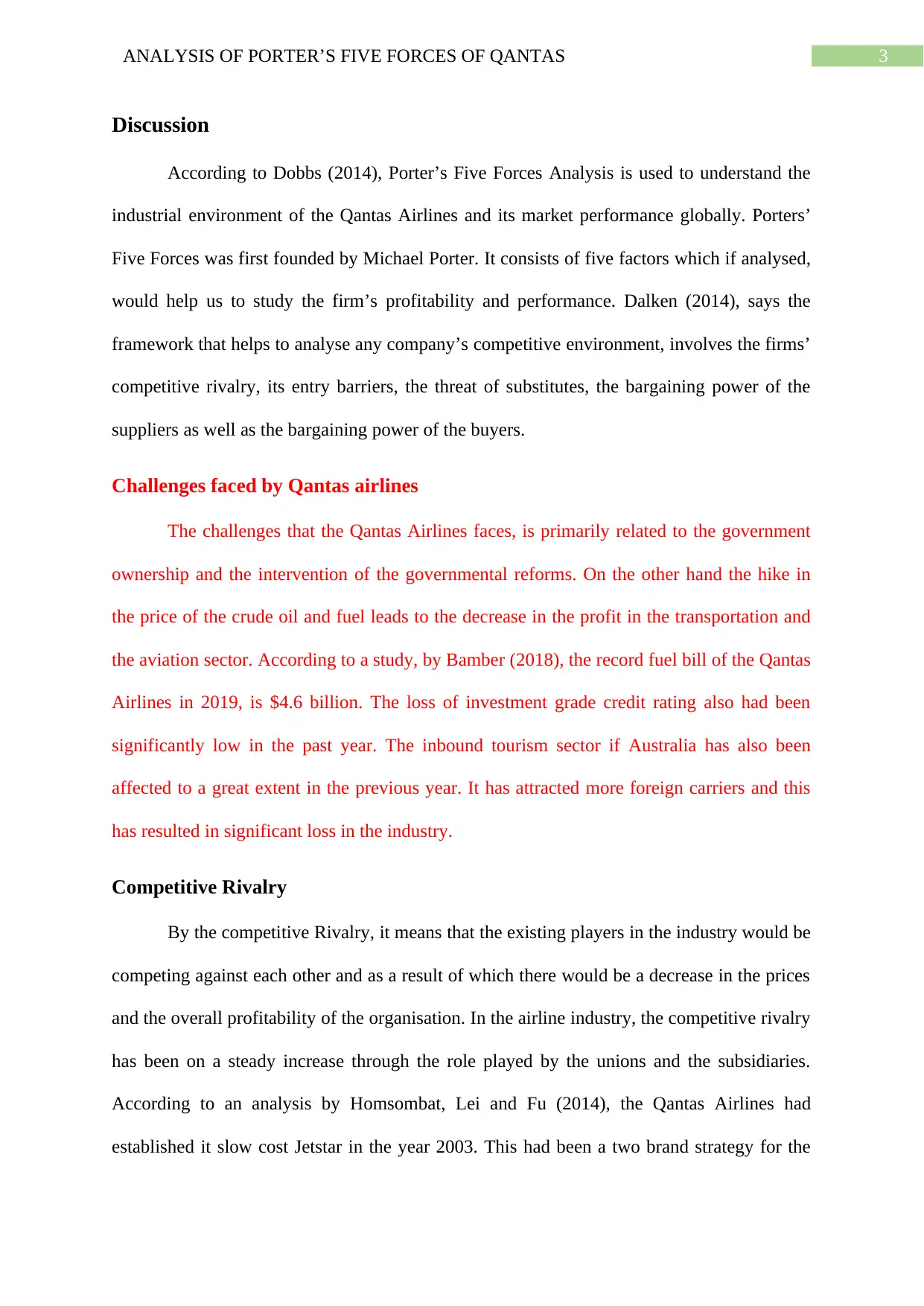
3ANALYSIS OF PORTER’S FIVE FORCES OF QANTAS
Discussion
According to Dobbs (2014), Porter’s Five Forces Analysis is used to understand the
industrial environment of the Qantas Airlines and its market performance globally. Porters’
Five Forces was first founded by Michael Porter. It consists of five factors which if analysed,
would help us to study the firm’s profitability and performance. Dalken (2014), says the
framework that helps to analyse any company’s competitive environment, involves the firms’
competitive rivalry, its entry barriers, the threat of substitutes, the bargaining power of the
suppliers as well as the bargaining power of the buyers.
Challenges faced by Qantas airlines
The challenges that the Qantas Airlines faces, is primarily related to the government
ownership and the intervention of the governmental reforms. On the other hand the hike in
the price of the crude oil and fuel leads to the decrease in the profit in the transportation and
the aviation sector. According to a study, by Bamber (2018), the record fuel bill of the Qantas
Airlines in 2019, is $4.6 billion. The loss of investment grade credit rating also had been
significantly low in the past year. The inbound tourism sector if Australia has also been
affected to a great extent in the previous year. It has attracted more foreign carriers and this
has resulted in significant loss in the industry.
Competitive Rivalry
By the competitive Rivalry, it means that the existing players in the industry would be
competing against each other and as a result of which there would be a decrease in the prices
and the overall profitability of the organisation. In the airline industry, the competitive rivalry
has been on a steady increase through the role played by the unions and the subsidiaries.
According to an analysis by Homsombat, Lei and Fu (2014), the Qantas Airlines had
established it slow cost Jetstar in the year 2003. This had been a two brand strategy for the
Discussion
According to Dobbs (2014), Porter’s Five Forces Analysis is used to understand the
industrial environment of the Qantas Airlines and its market performance globally. Porters’
Five Forces was first founded by Michael Porter. It consists of five factors which if analysed,
would help us to study the firm’s profitability and performance. Dalken (2014), says the
framework that helps to analyse any company’s competitive environment, involves the firms’
competitive rivalry, its entry barriers, the threat of substitutes, the bargaining power of the
suppliers as well as the bargaining power of the buyers.
Challenges faced by Qantas airlines
The challenges that the Qantas Airlines faces, is primarily related to the government
ownership and the intervention of the governmental reforms. On the other hand the hike in
the price of the crude oil and fuel leads to the decrease in the profit in the transportation and
the aviation sector. According to a study, by Bamber (2018), the record fuel bill of the Qantas
Airlines in 2019, is $4.6 billion. The loss of investment grade credit rating also had been
significantly low in the past year. The inbound tourism sector if Australia has also been
affected to a great extent in the previous year. It has attracted more foreign carriers and this
has resulted in significant loss in the industry.
Competitive Rivalry
By the competitive Rivalry, it means that the existing players in the industry would be
competing against each other and as a result of which there would be a decrease in the prices
and the overall profitability of the organisation. In the airline industry, the competitive rivalry
has been on a steady increase through the role played by the unions and the subsidiaries.
According to an analysis by Homsombat, Lei and Fu (2014), the Qantas Airlines had
established it slow cost Jetstar in the year 2003. This had been a two brand strategy for the
Paraphrase This Document
Need a fresh take? Get an instant paraphrase of this document with our AI Paraphraser
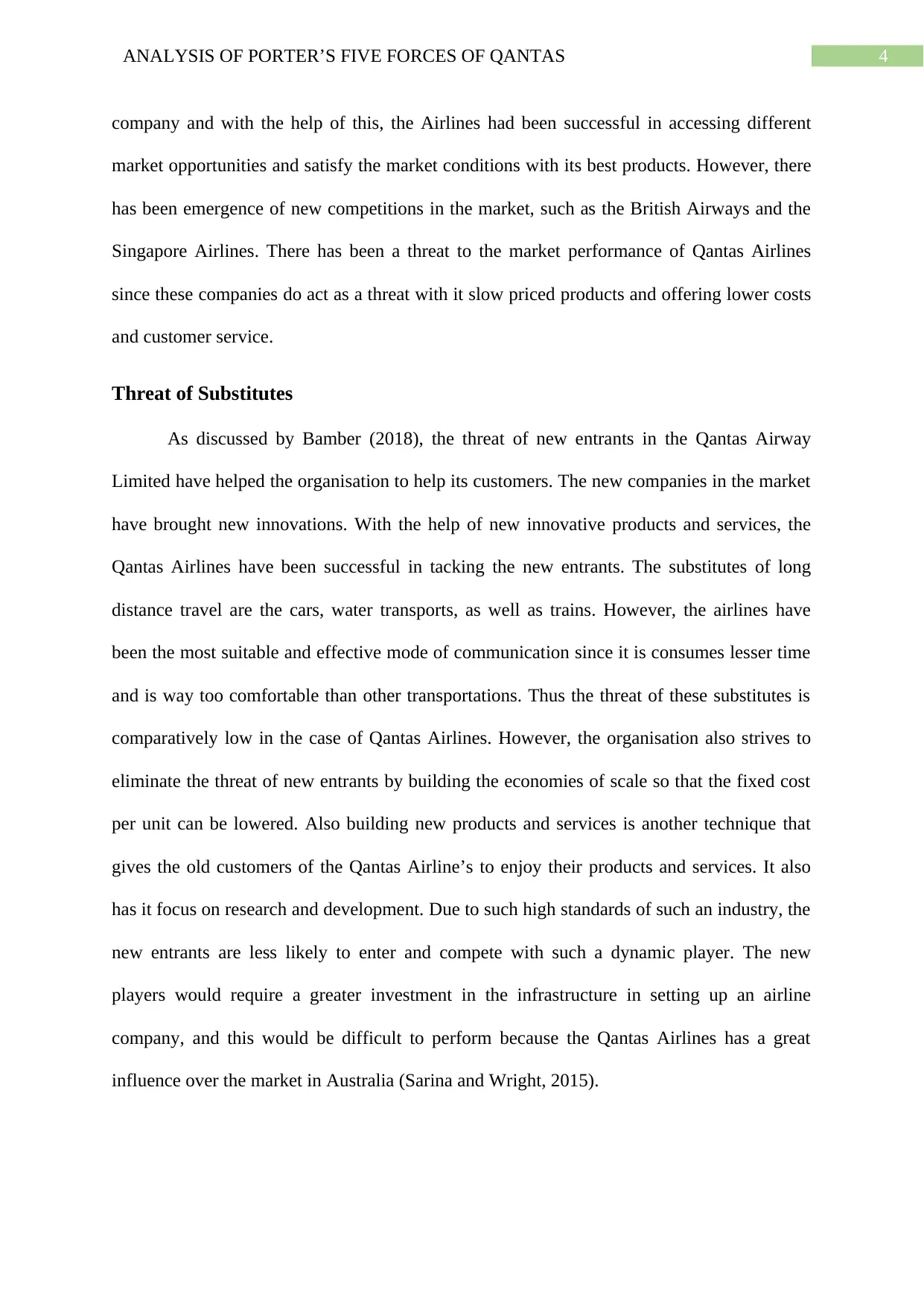
4ANALYSIS OF PORTER’S FIVE FORCES OF QANTAS
company and with the help of this, the Airlines had been successful in accessing different
market opportunities and satisfy the market conditions with its best products. However, there
has been emergence of new competitions in the market, such as the British Airways and the
Singapore Airlines. There has been a threat to the market performance of Qantas Airlines
since these companies do act as a threat with it slow priced products and offering lower costs
and customer service.
Threat of Substitutes
As discussed by Bamber (2018), the threat of new entrants in the Qantas Airway
Limited have helped the organisation to help its customers. The new companies in the market
have brought new innovations. With the help of new innovative products and services, the
Qantas Airlines have been successful in tacking the new entrants. The substitutes of long
distance travel are the cars, water transports, as well as trains. However, the airlines have
been the most suitable and effective mode of communication since it is consumes lesser time
and is way too comfortable than other transportations. Thus the threat of these substitutes is
comparatively low in the case of Qantas Airlines. However, the organisation also strives to
eliminate the threat of new entrants by building the economies of scale so that the fixed cost
per unit can be lowered. Also building new products and services is another technique that
gives the old customers of the Qantas Airline’s to enjoy their products and services. It also
has it focus on research and development. Due to such high standards of such an industry, the
new entrants are less likely to enter and compete with such a dynamic player. The new
players would require a greater investment in the infrastructure in setting up an airline
company, and this would be difficult to perform because the Qantas Airlines has a great
influence over the market in Australia (Sarina and Wright, 2015).
company and with the help of this, the Airlines had been successful in accessing different
market opportunities and satisfy the market conditions with its best products. However, there
has been emergence of new competitions in the market, such as the British Airways and the
Singapore Airlines. There has been a threat to the market performance of Qantas Airlines
since these companies do act as a threat with it slow priced products and offering lower costs
and customer service.
Threat of Substitutes
As discussed by Bamber (2018), the threat of new entrants in the Qantas Airway
Limited have helped the organisation to help its customers. The new companies in the market
have brought new innovations. With the help of new innovative products and services, the
Qantas Airlines have been successful in tacking the new entrants. The substitutes of long
distance travel are the cars, water transports, as well as trains. However, the airlines have
been the most suitable and effective mode of communication since it is consumes lesser time
and is way too comfortable than other transportations. Thus the threat of these substitutes is
comparatively low in the case of Qantas Airlines. However, the organisation also strives to
eliminate the threat of new entrants by building the economies of scale so that the fixed cost
per unit can be lowered. Also building new products and services is another technique that
gives the old customers of the Qantas Airline’s to enjoy their products and services. It also
has it focus on research and development. Due to such high standards of such an industry, the
new entrants are less likely to enter and compete with such a dynamic player. The new
players would require a greater investment in the infrastructure in setting up an airline
company, and this would be difficult to perform because the Qantas Airlines has a great
influence over the market in Australia (Sarina and Wright, 2015).
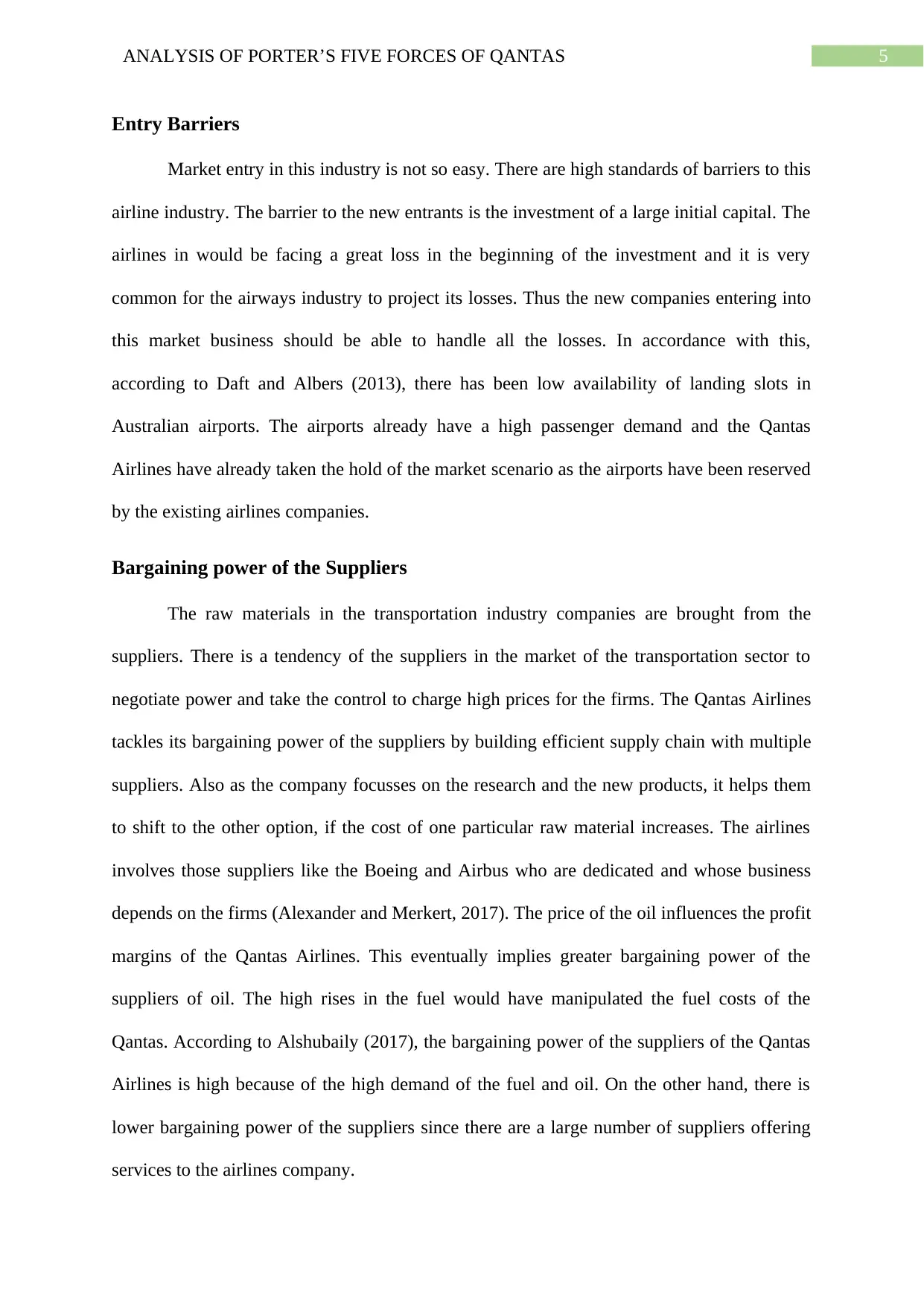
5ANALYSIS OF PORTER’S FIVE FORCES OF QANTAS
Entry Barriers
Market entry in this industry is not so easy. There are high standards of barriers to this
airline industry. The barrier to the new entrants is the investment of a large initial capital. The
airlines in would be facing a great loss in the beginning of the investment and it is very
common for the airways industry to project its losses. Thus the new companies entering into
this market business should be able to handle all the losses. In accordance with this,
according to Daft and Albers (2013), there has been low availability of landing slots in
Australian airports. The airports already have a high passenger demand and the Qantas
Airlines have already taken the hold of the market scenario as the airports have been reserved
by the existing airlines companies.
Bargaining power of the Suppliers
The raw materials in the transportation industry companies are brought from the
suppliers. There is a tendency of the suppliers in the market of the transportation sector to
negotiate power and take the control to charge high prices for the firms. The Qantas Airlines
tackles its bargaining power of the suppliers by building efficient supply chain with multiple
suppliers. Also as the company focusses on the research and the new products, it helps them
to shift to the other option, if the cost of one particular raw material increases. The airlines
involves those suppliers like the Boeing and Airbus who are dedicated and whose business
depends on the firms (Alexander and Merkert, 2017). The price of the oil influences the profit
margins of the Qantas Airlines. This eventually implies greater bargaining power of the
suppliers of oil. The high rises in the fuel would have manipulated the fuel costs of the
Qantas. According to Alshubaily (2017), the bargaining power of the suppliers of the Qantas
Airlines is high because of the high demand of the fuel and oil. On the other hand, there is
lower bargaining power of the suppliers since there are a large number of suppliers offering
services to the airlines company.
Entry Barriers
Market entry in this industry is not so easy. There are high standards of barriers to this
airline industry. The barrier to the new entrants is the investment of a large initial capital. The
airlines in would be facing a great loss in the beginning of the investment and it is very
common for the airways industry to project its losses. Thus the new companies entering into
this market business should be able to handle all the losses. In accordance with this,
according to Daft and Albers (2013), there has been low availability of landing slots in
Australian airports. The airports already have a high passenger demand and the Qantas
Airlines have already taken the hold of the market scenario as the airports have been reserved
by the existing airlines companies.
Bargaining power of the Suppliers
The raw materials in the transportation industry companies are brought from the
suppliers. There is a tendency of the suppliers in the market of the transportation sector to
negotiate power and take the control to charge high prices for the firms. The Qantas Airlines
tackles its bargaining power of the suppliers by building efficient supply chain with multiple
suppliers. Also as the company focusses on the research and the new products, it helps them
to shift to the other option, if the cost of one particular raw material increases. The airlines
involves those suppliers like the Boeing and Airbus who are dedicated and whose business
depends on the firms (Alexander and Merkert, 2017). The price of the oil influences the profit
margins of the Qantas Airlines. This eventually implies greater bargaining power of the
suppliers of oil. The high rises in the fuel would have manipulated the fuel costs of the
Qantas. According to Alshubaily (2017), the bargaining power of the suppliers of the Qantas
Airlines is high because of the high demand of the fuel and oil. On the other hand, there is
lower bargaining power of the suppliers since there are a large number of suppliers offering
services to the airlines company.
⊘ This is a preview!⊘
Do you want full access?
Subscribe today to unlock all pages.

Trusted by 1+ million students worldwide
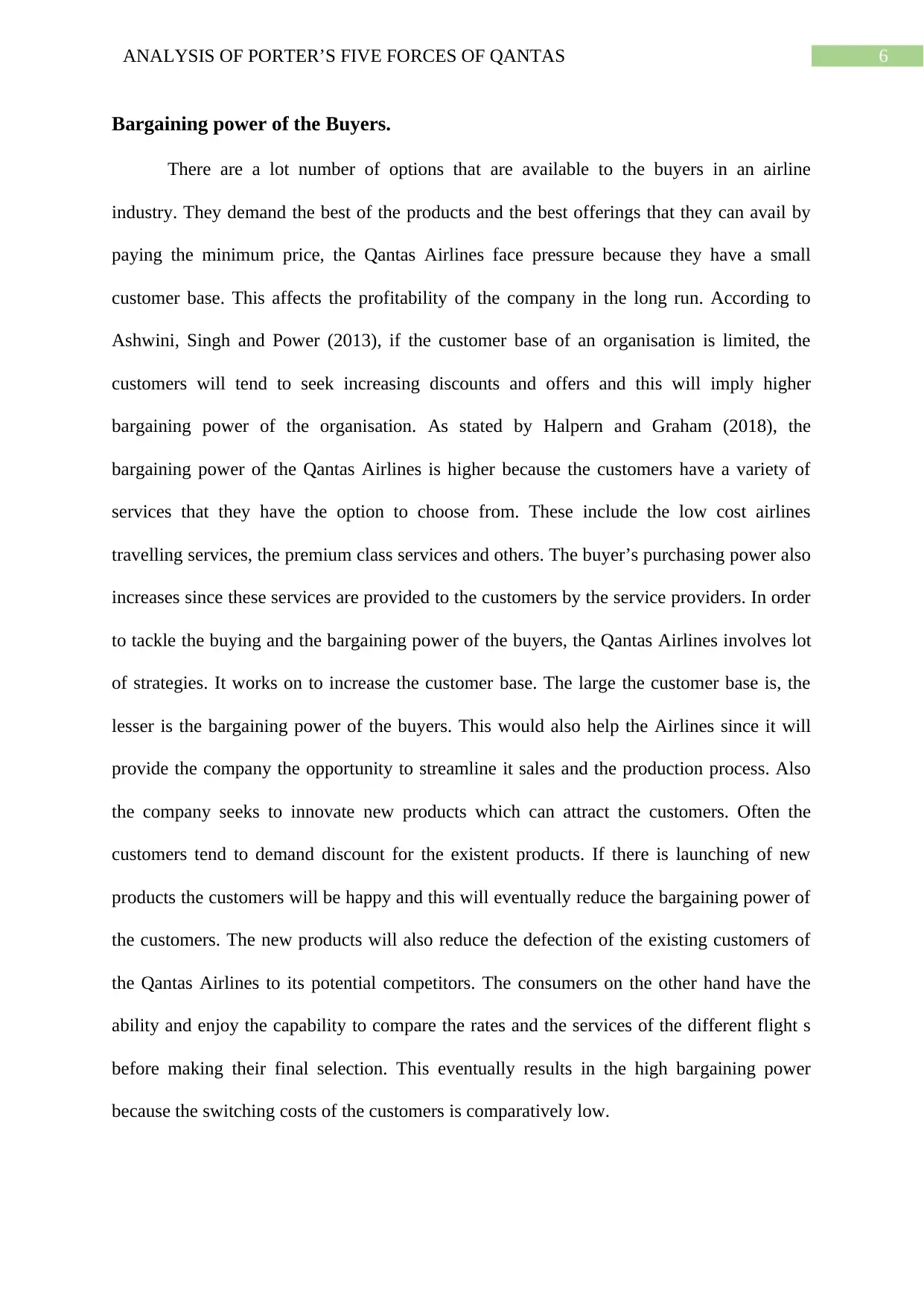
6ANALYSIS OF PORTER’S FIVE FORCES OF QANTAS
Bargaining power of the Buyers.
There are a lot number of options that are available to the buyers in an airline
industry. They demand the best of the products and the best offerings that they can avail by
paying the minimum price, the Qantas Airlines face pressure because they have a small
customer base. This affects the profitability of the company in the long run. According to
Ashwini, Singh and Power (2013), if the customer base of an organisation is limited, the
customers will tend to seek increasing discounts and offers and this will imply higher
bargaining power of the organisation. As stated by Halpern and Graham (2018), the
bargaining power of the Qantas Airlines is higher because the customers have a variety of
services that they have the option to choose from. These include the low cost airlines
travelling services, the premium class services and others. The buyer’s purchasing power also
increases since these services are provided to the customers by the service providers. In order
to tackle the buying and the bargaining power of the buyers, the Qantas Airlines involves lot
of strategies. It works on to increase the customer base. The large the customer base is, the
lesser is the bargaining power of the buyers. This would also help the Airlines since it will
provide the company the opportunity to streamline it sales and the production process. Also
the company seeks to innovate new products which can attract the customers. Often the
customers tend to demand discount for the existent products. If there is launching of new
products the customers will be happy and this will eventually reduce the bargaining power of
the customers. The new products will also reduce the defection of the existing customers of
the Qantas Airlines to its potential competitors. The consumers on the other hand have the
ability and enjoy the capability to compare the rates and the services of the different flight s
before making their final selection. This eventually results in the high bargaining power
because the switching costs of the customers is comparatively low.
Bargaining power of the Buyers.
There are a lot number of options that are available to the buyers in an airline
industry. They demand the best of the products and the best offerings that they can avail by
paying the minimum price, the Qantas Airlines face pressure because they have a small
customer base. This affects the profitability of the company in the long run. According to
Ashwini, Singh and Power (2013), if the customer base of an organisation is limited, the
customers will tend to seek increasing discounts and offers and this will imply higher
bargaining power of the organisation. As stated by Halpern and Graham (2018), the
bargaining power of the Qantas Airlines is higher because the customers have a variety of
services that they have the option to choose from. These include the low cost airlines
travelling services, the premium class services and others. The buyer’s purchasing power also
increases since these services are provided to the customers by the service providers. In order
to tackle the buying and the bargaining power of the buyers, the Qantas Airlines involves lot
of strategies. It works on to increase the customer base. The large the customer base is, the
lesser is the bargaining power of the buyers. This would also help the Airlines since it will
provide the company the opportunity to streamline it sales and the production process. Also
the company seeks to innovate new products which can attract the customers. Often the
customers tend to demand discount for the existent products. If there is launching of new
products the customers will be happy and this will eventually reduce the bargaining power of
the customers. The new products will also reduce the defection of the existing customers of
the Qantas Airlines to its potential competitors. The consumers on the other hand have the
ability and enjoy the capability to compare the rates and the services of the different flight s
before making their final selection. This eventually results in the high bargaining power
because the switching costs of the customers is comparatively low.
Paraphrase This Document
Need a fresh take? Get an instant paraphrase of this document with our AI Paraphraser
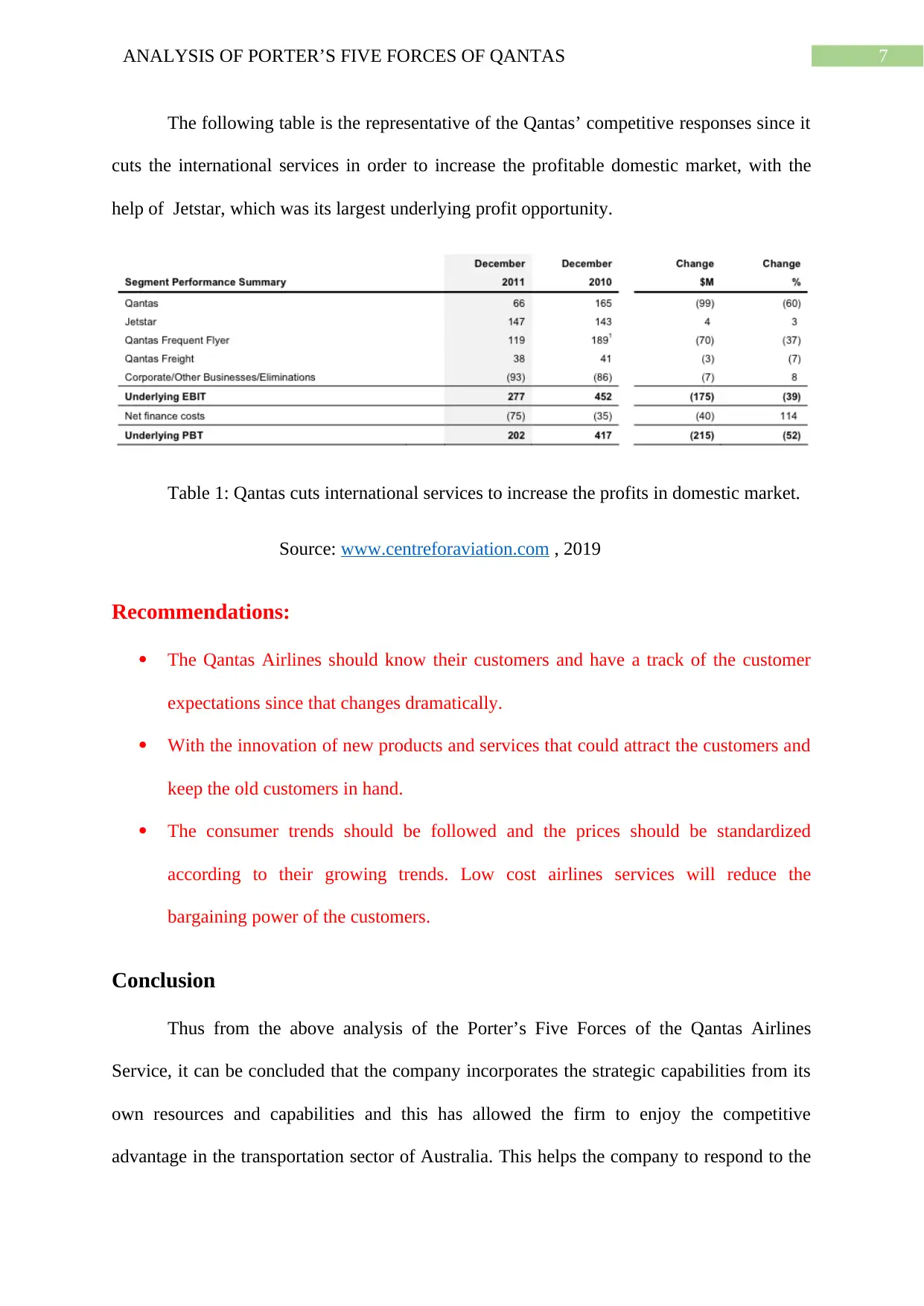
7ANALYSIS OF PORTER’S FIVE FORCES OF QANTAS
The following table is the representative of the Qantas’ competitive responses since it
cuts the international services in order to increase the profitable domestic market, with the
help of Jetstar, which was its largest underlying profit opportunity.
Table 1: Qantas cuts international services to increase the profits in domestic market.
Source: www.centreforaviation.com , 2019
Recommendations:
The Qantas Airlines should know their customers and have a track of the customer
expectations since that changes dramatically.
With the innovation of new products and services that could attract the customers and
keep the old customers in hand.
The consumer trends should be followed and the prices should be standardized
according to their growing trends. Low cost airlines services will reduce the
bargaining power of the customers.
Conclusion
Thus from the above analysis of the Porter’s Five Forces of the Qantas Airlines
Service, it can be concluded that the company incorporates the strategic capabilities from its
own resources and capabilities and this has allowed the firm to enjoy the competitive
advantage in the transportation sector of Australia. This helps the company to respond to the
The following table is the representative of the Qantas’ competitive responses since it
cuts the international services in order to increase the profitable domestic market, with the
help of Jetstar, which was its largest underlying profit opportunity.
Table 1: Qantas cuts international services to increase the profits in domestic market.
Source: www.centreforaviation.com , 2019
Recommendations:
The Qantas Airlines should know their customers and have a track of the customer
expectations since that changes dramatically.
With the innovation of new products and services that could attract the customers and
keep the old customers in hand.
The consumer trends should be followed and the prices should be standardized
according to their growing trends. Low cost airlines services will reduce the
bargaining power of the customers.
Conclusion
Thus from the above analysis of the Porter’s Five Forces of the Qantas Airlines
Service, it can be concluded that the company incorporates the strategic capabilities from its
own resources and capabilities and this has allowed the firm to enjoy the competitive
advantage in the transportation sector of Australia. This helps the company to respond to the
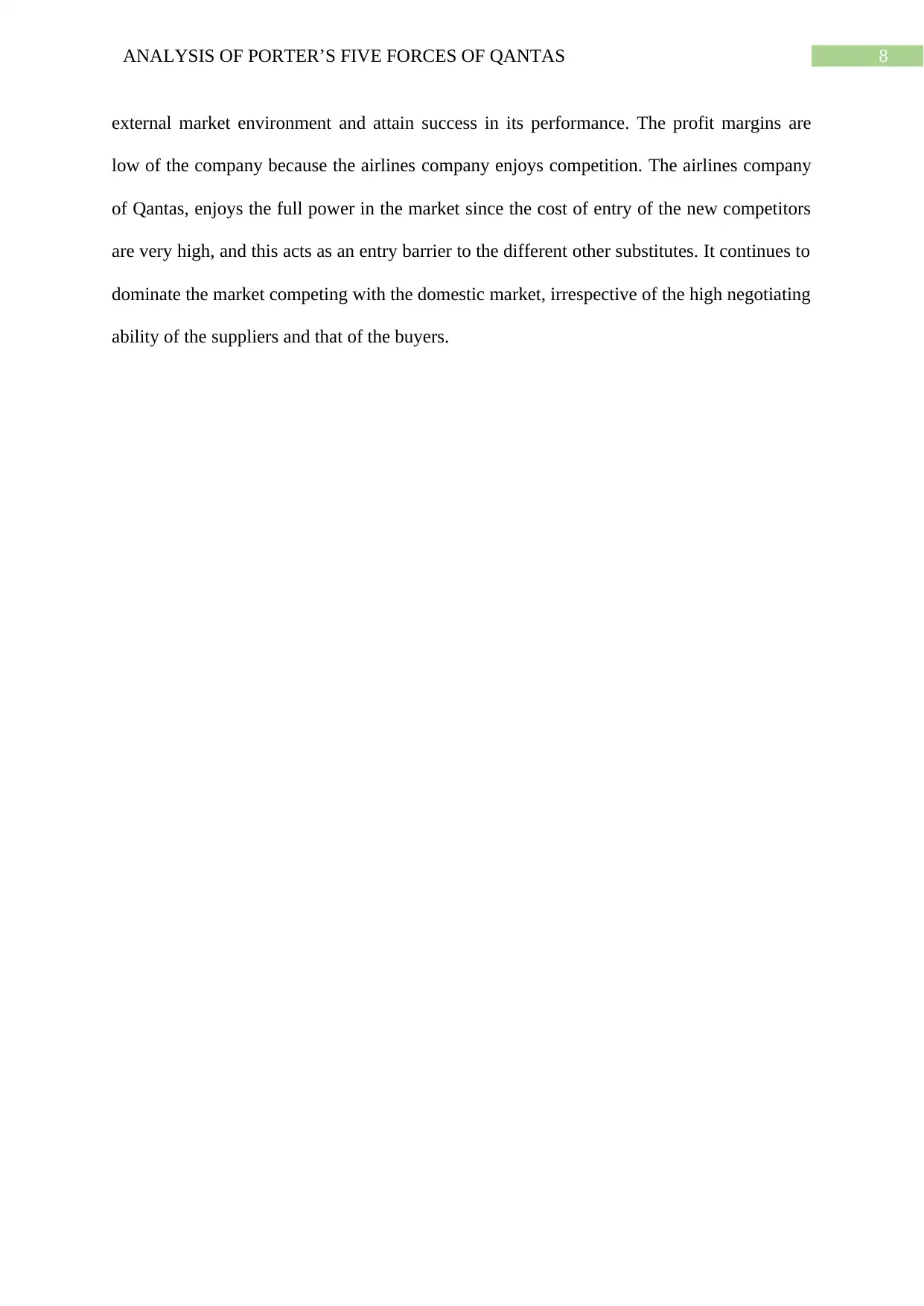
8ANALYSIS OF PORTER’S FIVE FORCES OF QANTAS
external market environment and attain success in its performance. The profit margins are
low of the company because the airlines company enjoys competition. The airlines company
of Qantas, enjoys the full power in the market since the cost of entry of the new competitors
are very high, and this acts as an entry barrier to the different other substitutes. It continues to
dominate the market competing with the domestic market, irrespective of the high negotiating
ability of the suppliers and that of the buyers.
external market environment and attain success in its performance. The profit margins are
low of the company because the airlines company enjoys competition. The airlines company
of Qantas, enjoys the full power in the market since the cost of entry of the new competitors
are very high, and this acts as an entry barrier to the different other substitutes. It continues to
dominate the market competing with the domestic market, irrespective of the high negotiating
ability of the suppliers and that of the buyers.
⊘ This is a preview!⊘
Do you want full access?
Subscribe today to unlock all pages.

Trusted by 1+ million students worldwide
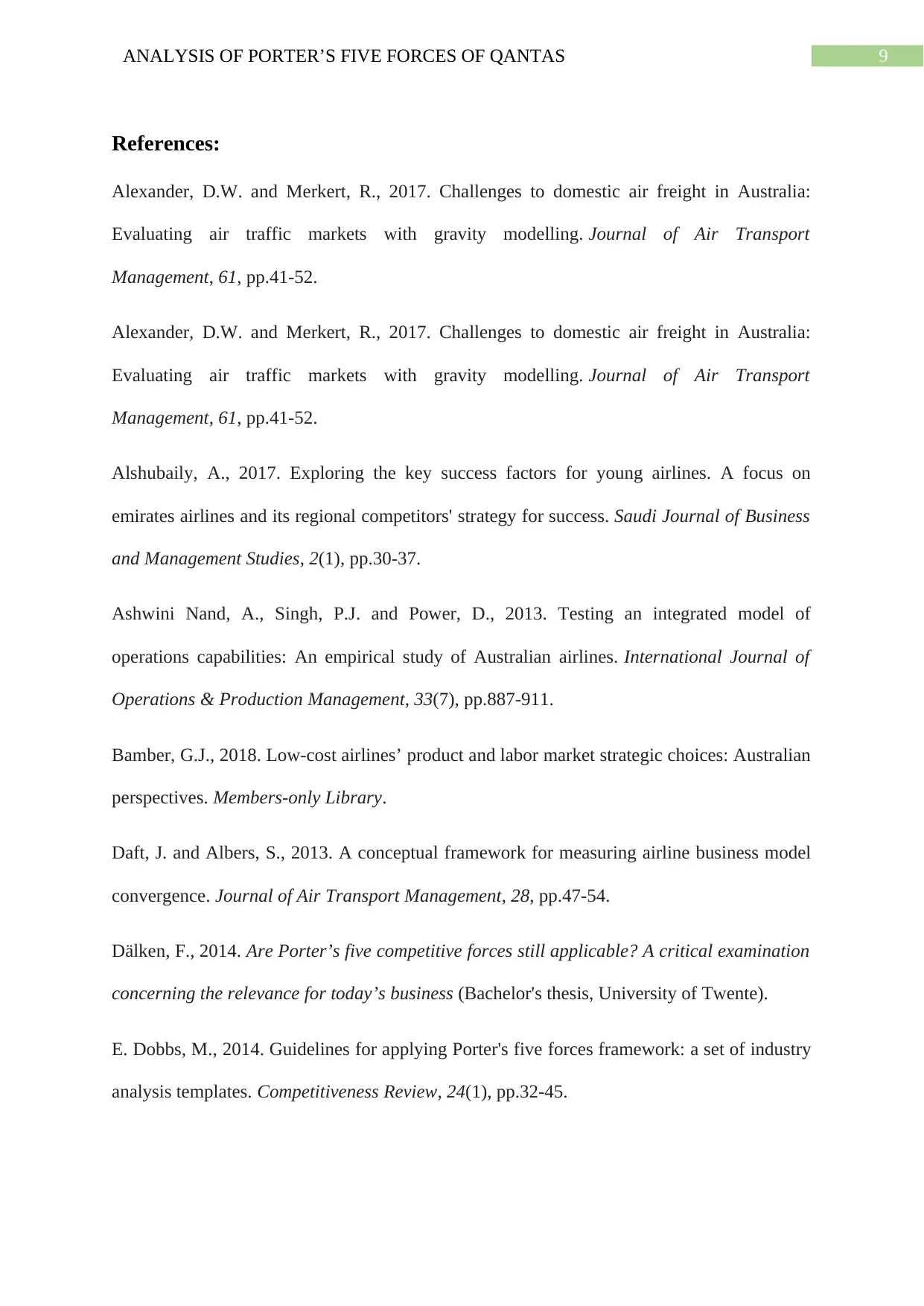
9ANALYSIS OF PORTER’S FIVE FORCES OF QANTAS
References:
Alexander, D.W. and Merkert, R., 2017. Challenges to domestic air freight in Australia:
Evaluating air traffic markets with gravity modelling. Journal of Air Transport
Management, 61, pp.41-52.
Alexander, D.W. and Merkert, R., 2017. Challenges to domestic air freight in Australia:
Evaluating air traffic markets with gravity modelling. Journal of Air Transport
Management, 61, pp.41-52.
Alshubaily, A., 2017. Exploring the key success factors for young airlines. A focus on
emirates airlines and its regional competitors' strategy for success. Saudi Journal of Business
and Management Studies, 2(1), pp.30-37.
Ashwini Nand, A., Singh, P.J. and Power, D., 2013. Testing an integrated model of
operations capabilities: An empirical study of Australian airlines. International Journal of
Operations & Production Management, 33(7), pp.887-911.
Bamber, G.J., 2018. Low-cost airlines’ product and labor market strategic choices: Australian
perspectives. Members-only Library.
Daft, J. and Albers, S., 2013. A conceptual framework for measuring airline business model
convergence. Journal of Air Transport Management, 28, pp.47-54.
Dälken, F., 2014. Are Porter’s five competitive forces still applicable? A critical examination
concerning the relevance for today’s business (Bachelor's thesis, University of Twente).
E. Dobbs, M., 2014. Guidelines for applying Porter's five forces framework: a set of industry
analysis templates. Competitiveness Review, 24(1), pp.32-45.
References:
Alexander, D.W. and Merkert, R., 2017. Challenges to domestic air freight in Australia:
Evaluating air traffic markets with gravity modelling. Journal of Air Transport
Management, 61, pp.41-52.
Alexander, D.W. and Merkert, R., 2017. Challenges to domestic air freight in Australia:
Evaluating air traffic markets with gravity modelling. Journal of Air Transport
Management, 61, pp.41-52.
Alshubaily, A., 2017. Exploring the key success factors for young airlines. A focus on
emirates airlines and its regional competitors' strategy for success. Saudi Journal of Business
and Management Studies, 2(1), pp.30-37.
Ashwini Nand, A., Singh, P.J. and Power, D., 2013. Testing an integrated model of
operations capabilities: An empirical study of Australian airlines. International Journal of
Operations & Production Management, 33(7), pp.887-911.
Bamber, G.J., 2018. Low-cost airlines’ product and labor market strategic choices: Australian
perspectives. Members-only Library.
Daft, J. and Albers, S., 2013. A conceptual framework for measuring airline business model
convergence. Journal of Air Transport Management, 28, pp.47-54.
Dälken, F., 2014. Are Porter’s five competitive forces still applicable? A critical examination
concerning the relevance for today’s business (Bachelor's thesis, University of Twente).
E. Dobbs, M., 2014. Guidelines for applying Porter's five forces framework: a set of industry
analysis templates. Competitiveness Review, 24(1), pp.32-45.
Paraphrase This Document
Need a fresh take? Get an instant paraphrase of this document with our AI Paraphraser
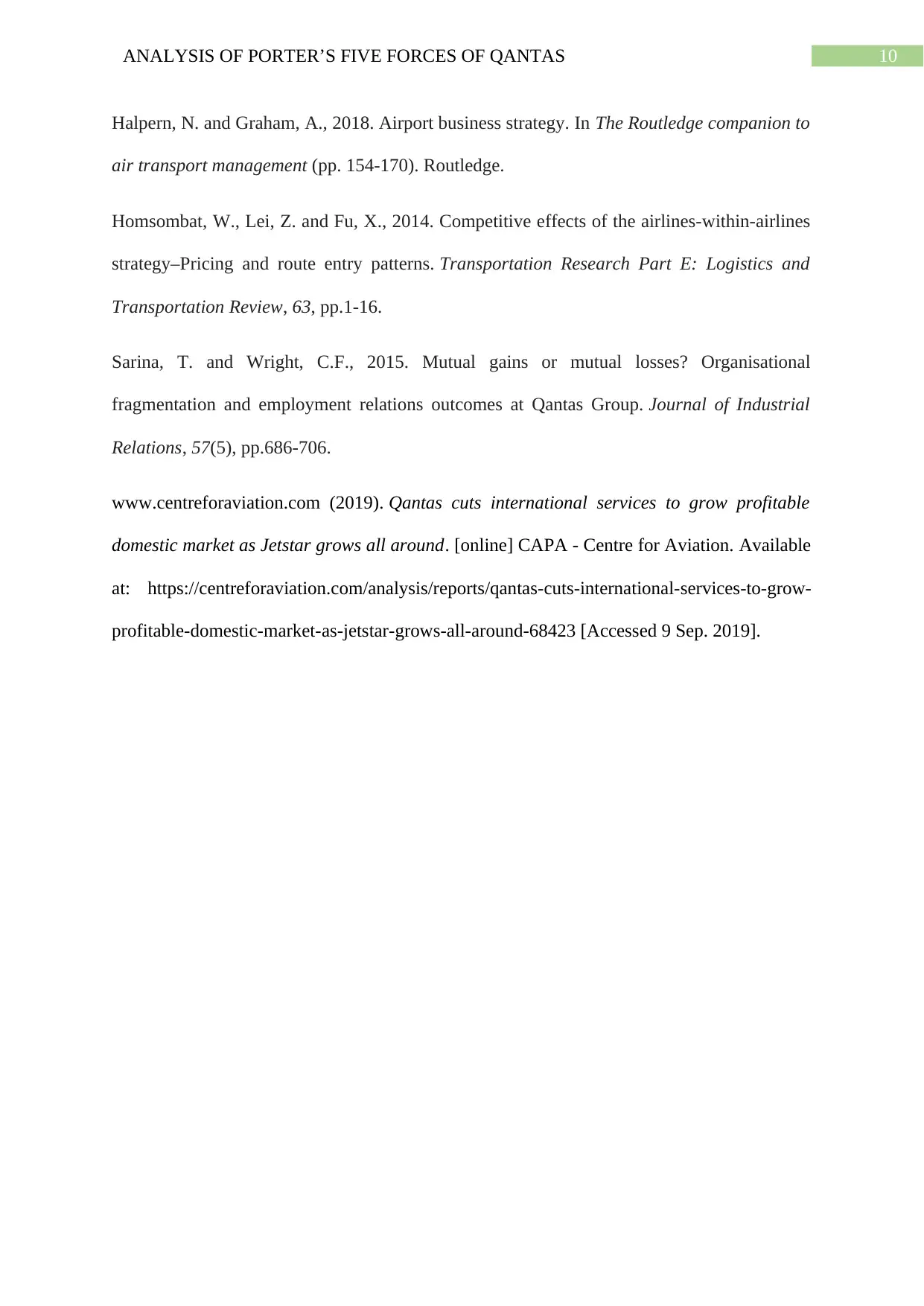
10ANALYSIS OF PORTER’S FIVE FORCES OF QANTAS
Halpern, N. and Graham, A., 2018. Airport business strategy. In The Routledge companion to
air transport management (pp. 154-170). Routledge.
Homsombat, W., Lei, Z. and Fu, X., 2014. Competitive effects of the airlines-within-airlines
strategy–Pricing and route entry patterns. Transportation Research Part E: Logistics and
Transportation Review, 63, pp.1-16.
Sarina, T. and Wright, C.F., 2015. Mutual gains or mutual losses? Organisational
fragmentation and employment relations outcomes at Qantas Group. Journal of Industrial
Relations, 57(5), pp.686-706.
www.centreforaviation.com (2019). Qantas cuts international services to grow profitable
domestic market as Jetstar grows all around. [online] CAPA - Centre for Aviation. Available
at: https://centreforaviation.com/analysis/reports/qantas-cuts-international-services-to-grow-
profitable-domestic-market-as-jetstar-grows-all-around-68423 [Accessed 9 Sep. 2019].
Halpern, N. and Graham, A., 2018. Airport business strategy. In The Routledge companion to
air transport management (pp. 154-170). Routledge.
Homsombat, W., Lei, Z. and Fu, X., 2014. Competitive effects of the airlines-within-airlines
strategy–Pricing and route entry patterns. Transportation Research Part E: Logistics and
Transportation Review, 63, pp.1-16.
Sarina, T. and Wright, C.F., 2015. Mutual gains or mutual losses? Organisational
fragmentation and employment relations outcomes at Qantas Group. Journal of Industrial
Relations, 57(5), pp.686-706.
www.centreforaviation.com (2019). Qantas cuts international services to grow profitable
domestic market as Jetstar grows all around. [online] CAPA - Centre for Aviation. Available
at: https://centreforaviation.com/analysis/reports/qantas-cuts-international-services-to-grow-
profitable-domestic-market-as-jetstar-grows-all-around-68423 [Accessed 9 Sep. 2019].
1 out of 11
Related Documents
Your All-in-One AI-Powered Toolkit for Academic Success.
+13062052269
info@desklib.com
Available 24*7 on WhatsApp / Email
![[object Object]](/_next/static/media/star-bottom.7253800d.svg)
Unlock your academic potential
Copyright © 2020–2025 A2Z Services. All Rights Reserved. Developed and managed by ZUCOL.




